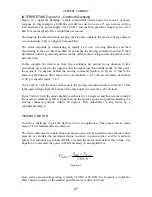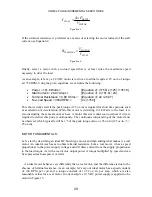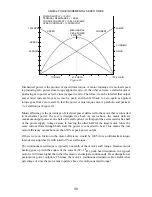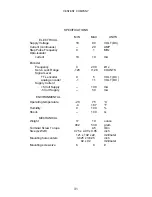
CENTENT COMPANY
IDEAL MOTOR
+
-
R
1
T
K
T
I =
LOAD
TORQUE
POWER
SUPPLY
V
= I x R
resistor
REAL MOTOR
R = TERMINAL RESISTANCE
K
= 13.52 OZ-IN/AMP
K
= 100 RPM/VOLT
TORQUE
SPEED
motor
supply
resistor
V
= V
- V
RPM = K x V
v
motor
-
+
Figure 15
The ideal motor turns at 1000 RPM with a 10 VDC power supply and its speed does not
change at all with load. It can drive an unlimited load, drawing unlimited current, and as long
as the power supply maintains voltage, the speed will remain at 1000 RPM. The motor
efficiency is 100% regardless of load simply because zero ohms dissipates no power. All
electrical power going into the motor is converted to mechanical power with perfect
efficiency. In short, speed is completely unrelated to torque, both are unlimited and
conversion efficiency is 100%.
A real-word motor differs from an ideal motor because it has electrical resistance. In fact, a
real motor can be modeled as an ideal motor in series with a resistor.
If we take our previously described ideal motor and add a 1 ohm resistor (a reasonable value)
in series, it now very closely resembles a real motor. It will still draw a current proportional
to torque, but now the current passes through this resistor as well. The maximum current the
motor can draw is now limited by Ohm’s law to 10 amps, and is called the stall current.
Motor torque is also limited to the stall current times the torque constant, and is called the
stall torque.
The current passing through this resistor has three consequences. The resistance develops a
voltage drop across it (V = I R ), it dissipates power (W = I
2
R ) and it limits the motor’s
power output for a given power supply voltage.
The voltage drop subtracts from the power supply voltage, leaving less voltage across the
ideal motor. The motor now runs more slowly. At stall current, all the voltage is across the
resistor leaving nothing for the ideal motor. Since the ideal motor’s speed is proportional to
voltage, by definition the motor speed at stall is zero.
The power dissipated is subtracted from the total power going into the motor, leaving the
balance to be converted to mechanical power. This means efficiency becomes less than 100%
at any applied load and the motor generates heat.
29
Summary of Contents for CN0182
Page 4: ......




































